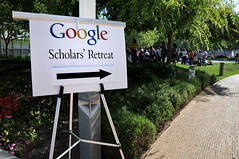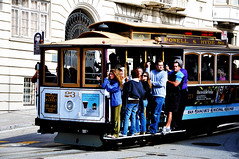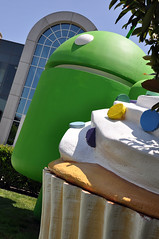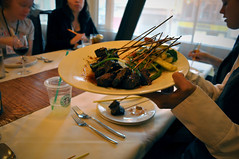I was ever so lucky to make it as a finalist for the Google Anita Borg Canada scholarship again this year. The best part of these awards, really, is the trip you get to take to visit Google and meet all the other inspiring scholarship winners. Last year it was
New York City, and this year it was San Francisco!
I was in San Francisco not so long ago for the
CRA-W Grad Cohort, but we stayed a little out of town, so I only saw a little bit of the city. I was pretty excited to stay right in the financial district this time and look around some more!
The plane ride in was mostly uneventful, though the connection from Denver to San Francisco was delayed over an hour. This wouldn't have been a problem if (a) we were still inside the airport with free WiFi, rather than on the plane, and (b) if there weren't a bunch of people waiting for me at the airport at the other end! I was so stressed. Either they all waited for me, in which case I felt bad delaying their sight-seeing, or they didn't wait, and I would be somewhat stranded, since I never actually figured out how to get to the hotel for myself (too busy thesis writing!). Luckily for me, they did wait. I want to repay their kindness but don't know how. (In fact, the opposite happened when I left to look around the city - one of the people who waited at the airport actually came down after us and we ended up leaving without her! I'm not sure how it happened, but I was told she had already left. So so so sorry!)
The hotel was right beside Chinatown, so that's where we went first. I loved the architecture! A great mix of traditional and modern.
The girls I was with had planned to check out the cable car museum. I didn't really know what it was all about. In fact, I just assumed that "cable car" referred to something like you'd see at the ski resort. Either that, or just a street car or bus powered by overhead wires (they did have that, too). My mind was pretty blown when I learned that there were literally giant loops of twisted cable going round and round under the streets. The cable cars hook this cable, and slowly clamp on with a vice, at which point the car gets pulled along its track. This replaced horse carts travelling up very steep hills (and sometimes not making it) back in the mid 1800's. Very ingenious design!
Later that evening, Google held a little welcome reception at the hotel. It was very nicely done, and I had a blast meeting a bunch of awesome people, even though I had to leave a bit early, having been awake for 20 hours due to the time change and early flight.
The next day, we took a shuttle to Mountain View to visit Google headquarters.
The day was full of tech talks, a tour, and food food food! At the ice cream social late in the afternoon, I heard that
Sergey made an appearance, but somehow I didn't seem to notice. Maybe I was too busy running around taking pictures of dinosaurs and stuff. ;)
Friday night's meal was at a nice Asian grill. Funnily enough, the concept was similar to the place we went to in New York City. You didn't order - they just brought you food platters and you ate what you felt like eating. Not a huge amount of variety was available, but certainly enough for everyone. We could have used some guys at our table, because the ten of us women couldn't eat it all! (I also learned that more than half our table was either married to or dating another computer scientist. For some reason, this made me smile.)
Finally, on Saturday morning, four scholars presented their research. By chance, it was all women who presented (there were guys there for some scholarships). I couldn't help but notice that the many questions asked were also by women (until the very end when a short and quiet question was finally asked by a male voice). Just a coincidence, but a nice change, anyway!
So once again, Google treats us right - thank you!! I hope to post about the technical talks over the coming days.
More photos available on Flickr.









